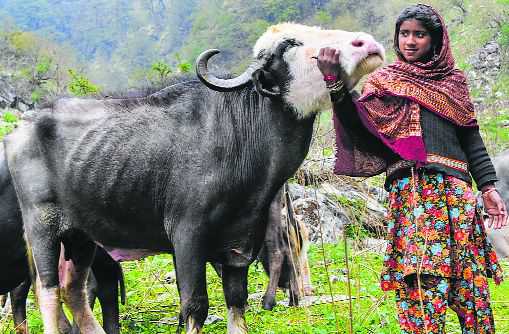Mobile education a distant dream for Gujjars
Balkrishan Prashar
Mobile schools for the Gujjar community remains a distant dream in Chamba district.
Despite the efforts made by the successive governments in the state to materialise the concept of opening mobile schools for the nomadic Gujjar community, nothing could be achieved in this direction as far as Chamba district is concerned.
The Gujjars, a majority of them Muslims, have the highest concentration in Chamba. They also dwell in parts of Kangra, Sirmaur and Bilaspur districts, but in much smaller numbers. The state government has constituted the Gujjar Welfare Board to ensure socio-economic uplift of this community like other such minorities including Gaddis, Gorkhas and Labanas.
Primarily, Gujjars lead a migratory life, as they move with their buffaloes from higher to lower areas in the winter season and vice-versa. As such, their children were deprived of regular school education. However, many of the Gujjars have lately set up permanent dwellings for their families in the lower parts of Chamba and Kangra districts to enable their children to get education.
A number of Gujjar families residing in the district are permanent inhabitants and are found in Churah, Salooni, Chamba and Bhattiyat subdivisions. Gujjars, who are mainly residing in the region, are the minority community of Chamba.
The district, with a population of 5,19,080 people as per the 2011 Census, has a sizeable number of Gujjar population (35,000 people) which is 6.25 per cent.
During the summer season, they go high up to the pastures (dhaars) to graze their herd of cattle, mainly buffaloes, and move down before the winter season. Rearing cattle is their main occupation.
Govt’s efforts made
in this direction
In 2009, while addressing a meeting of the Gujjar Welfare Board in Shimla, the then Himachal Chief Minister Prem Kumar Dhumal had planned to set up four residential elementary schools for the children of the Gujjar community. Locations for the schools were also decided. Two of these were planned at Shahpur and Nurpur in Kangra and two others in Chamba and Saho. The aim to open residential schools for nomadic children was to foster an atmosphere of mutuality and afford them equal educational opportunities besides other facilities for their rehabilitation. These schools, however, were converted into child caring institutes.
In 2014 also, the then Himachal Chief Minister, Virbhadra Singh, while presiding over the 19th meeting of the Gujjar Kalyan Board at Shimla, had announced a hostel for children of Gujjar families in Chamba and directed the officers of the Education Department to open schools for educating children of Gujjar community near their homes, irrespective of the requisite strength, so that besides carrying on with their traditional avocation, they could pay heed to their studies as well. However, this, too, could not materialise.
But the government is running 14 special schools called ‘non-residential special training (NRST) centres’ for the children of Gujjar families in Chamba district, where even dropout and overage children of other communities are admitted, so that they can improve their education level.
These schools are located in Chamba, Gehra, Hardaspura, Kalhel, and Tissa education blocks, says Suman Kumar Minhas, principal, District Institute of Education and Training (DIET) at Saroo in Chamba district, who is also the district project coordinator for the Zila Saksharta Samiti.
Minhas said teacher eligibility test (TET) qualified teachers have been deployed at these centres and some even have a B.Ed degree. Other teachers who are not B.Ed qualified are also hired to teach children.
Out of 111 children studying (up to Class V) in these 14 centres, 94 belong to the Muslim community, in which 50 are girls, Minhas said. “As per tentative figures, the literacy rate among Gujjar children is 75 to 80 per cent in the district,” Minhas said.
The concept of NRST centres started way back in 2002, when its name was Education Guarantee Centres which later changed to Special Training Centres and now to Non-Residential Special Training Centres.
“The response among the Gujjar community is also encouraging because they feel that their children were getting education near their homes,” said Liyakat Ali, a member of the Gujjar community. To promote education among children of Gujjar community, Deputy Commissioner of Chamba Harikesh Meena last year had submitted a project to the government under innovative activities for modernisation of madarsas in Chamba district, which was drawn under the Sarva Shiksha Abhiyan (SSA) at a notional cost of Rs 12 crore, for which approval is pending.
About mobile school
The idea to have a mobile school for Gujjars was to have a teacher, preferably from the Gujjar community, who would stay and move with the nomad families, and impart education to their children. But due to certain unavoidable circumstances, the concept of mobile schools was not successful.
Highest concentration of Gujjars in Chamba
- The Gujjars, a majority of them Muslims, have the highest concentration in Chamba. They also dwell in parts of Kangra, Sirmaur and Bilaspur districts, but in much smaller numbers. Rearing cattle is their main occupation.
- The state government has constituted the Gujjar Welfare Board to ensure socio-economic uplift of this community like other such minorities including Gaddis, Gorkhas and Labanas.
- Primarily, Gujjars lead a migratory life, as they move with their buffaloes from higher to lower areas in the winter season and vice-versa. As such, their children were deprived of regular school education. However, many of the Gujjars have lately set up permanent dwellings for their families in the lower parts of Chamba and Kangra districts to enable their children to get education.
- A number of Gujjar families residing in Chamba are permanent inhabitants and are found in Churah, Salooni, Chamba and Bhattiyat subdivisions. Gujjars, who are mainly residing in the region, are the minority community of Chamba.
- The district, with a population of 5,19,080 people as per the 2011 Census, has a sizeable number of Gujjar population (35,000 people) which is 6.25 per cent.









